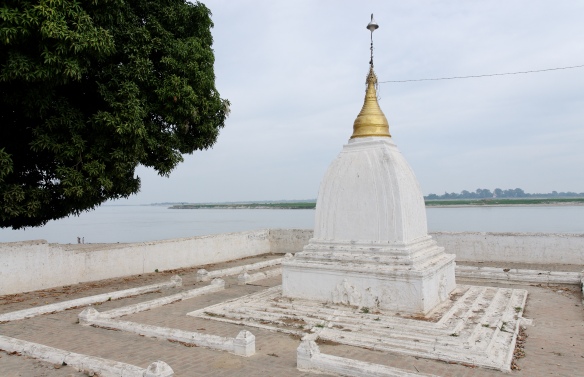Eric Arthur Blair, aka George Orwell, was an English novelist, essayist, journalist and keen social critic, born on June 25, 1903 in Motihari, India during the British Raj. His life and writings were strongly influenced by his years working as an imperial police officer in occupied Burma, at the time also still a province of British India. Orwell’s works include Burmese Days, Animal Farm, and 1984. In his honor I give you one of the posts I wrote after our visit to Burma, currently ruled by a military regime, currently known as Myanmar. – Jadi
We love travel. I refer to traveling to new cultures and places as connecting the dots. With each trip I feel a little more connected to the world at large and to the various dots that make up my picture of this planet and we who inhabit it.
While in Burma, we took a boat up the Irrawaddy River from Mandalay to Mingun for the day. Yet another fallen kingdom, Mingun is reknowned for the largest functioning bell in the world. It weighs in at 55,555 viss (90,718 kilograms or 199,999 pounds). The sound is a deep claaangg, rung by thumping the bell hard on the lip with a mallet. Mingun is also famous for the king who bankrupted his people with an attempt to outdo every shrine-builder who’d ever lived: King Bodawpaya wanted to build the huge stupa known as Mingun Pahtodawgyi.
It would be the highest in the world, a magnificent 150 meters tall, dwarfing everything built prior to it.

Work began in 1790.
King Bodawpaya never finished his religious edifice. He ran out of funds; or, halted construction due to a prophesy that his realm would end when the building was completed; or, that completing the stupa would signal his death. An earthquake on March 23, 1839 dislodged the huge bell and damaged the structure beyond saving. The Mingun Pahtodawgyi became the world’s largest pile of bricks…

The structure stands, all semi-finished 50 meters (150 feet) of it, roughly a third of the original planned height.
It’s a holy place and the faithful still come to worship. And the curious come to climb it [enter Jadi and Uwe, stage right]. Now, at any sacred Buddhist site, you remove your shoes at the base of the structure.

And you climb the stairs, barefoot, and then clambor on the ruins, barefoot, for one truly awe-inspiring view of the Irrawaddy River and the surrounding countryside.

Shan pilgrims in traditional outfits had also climbed the stupa and gave us the gift of their smiles and waves.

It was a magnificent afternoon and yet another highlight of our four weeks in Burma.

It wasn’t until we were safely home again that I got a good look at Uwe’s photographs.


There was a photo I had taken, too.

In memory of George Orwell, 25 June 1903 – 21 January 1950
NOTES: © Jadi Campbell 2013. Previously published as The World’s Largest Pile of Bricks. All photos © Uwe Hartmann. Reading this post is bittersweet. Burma is wracked by a terrible civil war. We wouldn’t be allowed to make this trip now. More pictures from our trip to Burma, and of Uwe’s photography, may be viewed at viewpics.de.
Click here for my author page to learn more about me and purchase my books.



Lovely post Jadi. It brought back memories of our time in Burma – we loved it. Sadly we were unable to climb the unfinished stupa ( wow those views from up there!) as another earthquake had damaged it further so climbing it was prohibited. It’s still a place of worship.
Alison
Alison it wasn’t until we were looking at our photos (back home and safe on the ground again) that we realized just how insane it was to climb the stupa… and to do it, barefoot.